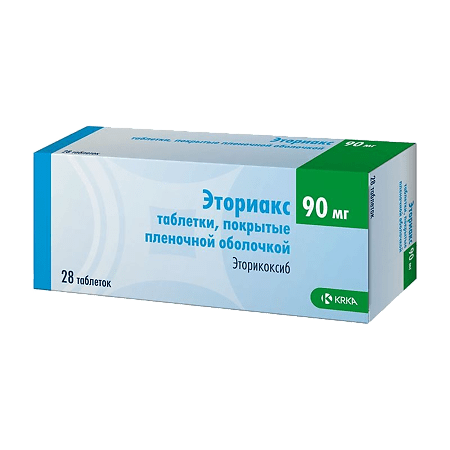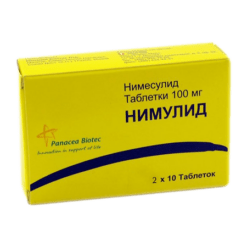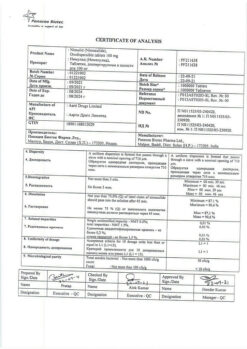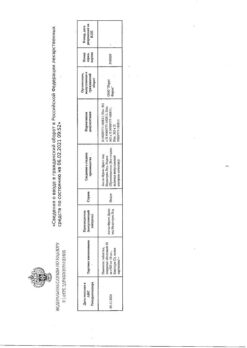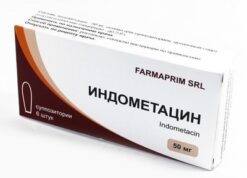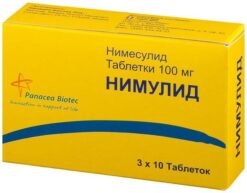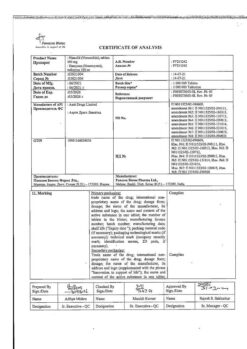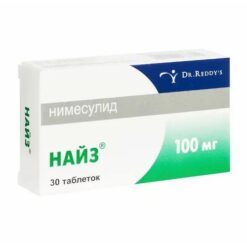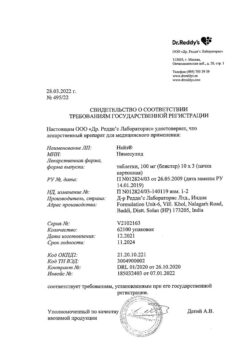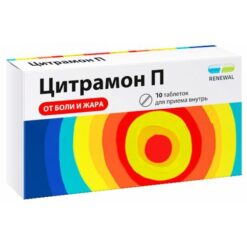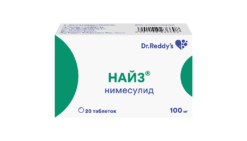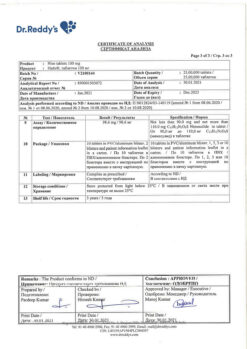No products in the cart.
Etoriax, 90 mg 7 pcs.
€1.00
Out of stock
(E-mail when Stock is available)
Description
Pharmacology
Mechanism of action
Etoricoxib is an oral, selective COX-2 inhibitor in the therapeutic dose range.
In clinical trials, etoricoxib caused dose-dependent inhibition of COX-2 without inhibiting COX-1 at doses up to 150 mg daily. Etoricoxib did not inhibit GH synthesis in the stomach and did not affect platelet function.
The COX is responsible for PG production. Two isoforms, COX-1 and COX-2, have been identified. COX-2 is the enzyme isoform that has been shown to be induced by proinflammatory stimuli and is thought to be primarily responsible for the synthesis of prostanoid mediators of pain, inflammation and fever. COX-2 is also involved in ovulation, implantation and closure of the arterial duct, regulation of renal function and CNS functions (fever induction, pain perception and cognitive functions), and may play a role in ulcer healing. COX-2 has been detected in tissues around gastric ulcers in humans, but its importance in ulcer healing has not been established.
Pharmacokinetics
Absorption
Orally taken etoricoxib is well absorbed. Absolute bioavailability is approximately 100%. Against a single daily dose of 120 mg to equilibrium Cmax in plasma (geometric mean – 3.6 µg/ml) was observed approximately 1 h after an adult fasting dose. The geometric mean AUC0-24 was 37.8 μg/h/ml. The pharmacokinetics of etoricoxib are linear over the therapeutic dose range.
A meal (high-calorie meal) had no effect on the degree of absorption of etoricoxib after a dose of 120 mg. The rate of absorption was impaired, resulting in a 36% decrease in Cmax and an increase in Tmax by 2 h. These data are not considered clinically significant. In clinical trials, etoricoxib was administered without regard to food intake.
Distribution
Etoricoxib is approximately 92% bound to human plasma proteins over a concentration range of 0.05 to 5 µg/mL. Vss in humans was approximately 120L. Etoricoxib penetrates through the placenta in rats and rabbits, as well as the GEB in rats.
Biotransformation
Etoricoxib is extensively metabolized, with 1% of the ingested dose excreted in the urine as an initial drug. The main metabolic pathway to form the 6′-hydroxymethyl derivative is catalyzed by CYP enzymes. CYP3A4 appears to be involved in the metabolism of etoricoxib in vivo. In vitro studies show that CYP2D6, CYP2C9, CYP1A2, and CYP2C19 can also catalyze the major metabolic pathway, but their quantitative role in vivo has not been studied.
Five metabolites have been identified in humans. The major metabolite is the 6′-carboxylic acid derivative of etoricoxib, formed by further oxidation of its 6′-hydroxymethyl derivative. These major metabolites either exhibit no measurable activity or only weak activity as COX-2 inhibitors. None of these metabolites inhibits COX-1.
Excretion
After intravenous administration of radioactively labeled etoricoxib to healthy volunteers at a single dose of 25 mg, 70% of the radioactivity was excreted in the urine and 20% in the feces, mostly as metabolites. Less than 2% was excreted as unchanged etoricoxib.
The elimination of etoricoxib occurs almost exclusively by metabolism followed by renal excretion. Stable concentrations of etoricoxib are achieved within seven days of a single daily dose of 120 mg, with an accumulation rate of approximately 2, corresponding to a T1/2 of approximately 22 h. Plasma clearance after intravenous administration of 25 mg is estimated to be approximately 50 ml/min.
Particular patient groups
Children. The pharmacokinetics of etoricoxib in pediatric patients (<12 years) have not been studied.
In a study (n=16) conducted with adolescents (12 to 17 years old) weighing 40 to 60 kg taking etoricoxib at a dose of 60 mg once daily and weighing >60 kg taking etoricoxib at a dose of 90 mg once daily, pharmacokinetic parameters were similar to those of adults taking etoricoxib at a dose of 90 mg once daily. The safety and efficacy of etoricoxib in pediatric patients have not been established.
Elderly age (>65 years). Pharmacokinetics in the elderly (65 years and older) are similar to those in the young.
Gender. The pharmacokinetics of etoricoxib are similar in men and women.
Hepatic impairment. In patients with mild hepatic impairment (5-6 Child-Pugh scores) taking etoricoxib at a dose of 60 mg once daily, mean AUC was approximately 16% higher compared to healthy subjects taking etoricoxib on the same regimen. In patients with moderate hepatic impairment (7-9 Child-Pugh scores) taking etoricoxib 60 mg every other day, the mean AUC was the same as in healthy subjects taking etoricoxib 60 mg once daily; etoricoxib in the 30 mg once daily dose has not been studied in this population. Clinical and pharmacokinetic data in patients with severe hepatic dysfunction (≥10 Child-Pugh score) are not available (see Contraindications).
Renal insufficiency. Pharmacokinetics of a single dose of etoricoxib 120 mg in patients with moderate to severe renal failure and patients with end-stage chronic renal disease under hemodialysis were not significantly different from those in healthy subjects. Hemodialysis had no significant effect on elimination (dialysis clearance is approximately 50 ml/min) (see Contraindications and Precautions).
Preclinical safety data
Preclinical studies have shown that etoricoxib is not genotoxic. Etoricoxib was not carcinogenic in mice. Rats developed hepatocellular and follicular-cell thyroid adenomas at a dose twice the daily dose for humans (90 mg), with systemic exposure to daily administration for about two years. The hepatocellular and follicular-cellular thyroid adenomas observed in rats are thought to result from a rat-specific mechanism involving induction of hepatic CYP450 enzymes. Etoricoxib has not been shown to cause induction of hepatic CYP3A enzymes in humans.
In rats, gastrointestinal toxicity of etoricoxib increased with increasing dose and time of exposure. In a 14-week toxicity study, etoricoxib caused GI ulcers at doses greater than the human therapeutic dose. In the 53- and 106-week toxicity studies, GI ulcers were also observed at exposures comparable to the human therapeutic dose. Renal and gastrointestinal abnormalities were observed in dogs when exposed to high doses.
Etoricoxib was not teratogenic in reproductive toxicity studies conducted in rats at a dose of 15 mg/kg/day (this is approximately 1.5 times the human daily dose (90 mg) for systemic exposure). In rabbits, there was an injection-related increase in cardiovascular malformations at exposures below clinical exposure at the human daily dose (90 mg). However, no treatment-associated external or skeletal fetal malformations were observed. In rats and rabbits, there was a dose-dependent increase in postimplantation loss at exposures greater than or equal to 1.5 times human exposure (see Contraindications and Use in Pregnancy and Lactation).
Etoricoxib is excreted in the milk of lactating rats at concentrations approximately twice as high as plasma concentrations. A decrease in body weight has been observed in infants whose mothers were administered etoricoxib during lactation.
Clinical Studies
Efficacy
In patients with osteoarthritis (OA), etoricoxib at a dose of 60 mg once daily provided significant pain relief and improved patients’ assessment of their condition. These positive effects were observed on the second day of therapy and persisted for 52 weeks. Studies using etoricoxib at a dose of 30 mg once daily demonstrated efficacy superior to placebo over a 12-week treatment period (using the same estimates as in the above studies). In the dose-matching study, etoricoxib at a dose of 60 mg demonstrated significantly greater improvement compared with the 30 mg dose on all 3 primary endpoints during the 6-week treatment period. The 30 mg dose has not been studied in hand OA.
In patients with rheumatoid arthritis (RA), etoricoxib doses of 60 and 90 mg once daily provided significant relief of pain, inflammation and increased mobility. In studies evaluating the 60 and 90 mg doses, these beneficial effects persisted over a 12-week treatment period. In a study evaluating a 60-mg dose versus a 90-mg dose, etoricoxib at 60 mg once daily and at 90 mg once daily was more effective than placebo. The 90 mg dose outperformed the 60 mg dose on patients’ overall pain scores (visual analog scale 0-100 mm), with a mean improvement of -2.71 mm (95% CI: -4.98; -0.45 mm).
In patients experiencing attacks of acute gouty arthritis, etoricoxib at a dose of 120 mg once daily over an eight-day treatment period relieved moderate to severe joint pain and inflammation to a degree comparable to using indomethacin at a dose of 50 mg 3 times daily. Pain relief was observed as early as 4 h after the start of treatment.
In patients with ankylosing spondylitis, etoricoxib at 90 mg once daily provided significant improvement in pain, inflammation, stiffness and spinal function. The clinical benefit of etoricoxib was observed as early as the second day after initiation of treatment and was sustained throughout the 52-week treatment period. In a second study evaluating a 60-mg dose compared with a 90-mg dose, etoricoxib at 60 mg daily and 90 mg daily demonstrated similar efficacy compared with naproxen at a dose of 1,000 mg daily. Among patients who responded inadequately to the 60 mg daily dose for 6 weeks, increasing the dose to 90 mg daily improved spinal pain intensity scores (0-100 mm on a visual analog scale) compared with continuing to take 60 mg daily, with an average improvement of -2.70 mm (95% CI: -4.88; -0.52 mm).
In a clinical study evaluating postoperative pain in dental interventions, etoricoxib at a dose of 90 mg was administered once daily for three days. In patients with moderate pain at baseline, etoricoxib in a 90-mg dose demonstrated an analgesic effect similar to that of ibuprofen in a 600-mg dose (16.11 vs. 16.39 p=0.722), and greater than the combination of paracetamol + codeine 600/60 mg (11, p<0.001) and placebo (6.84, p<0.001) on the index of total pain relief during the first 6 h (TOPARE). The proportion of patients reporting use of analgesic drugs within the first 24 h after administration was 40.8% for etoricoxib at 90 mg, 25.5% for ibuprofen at 600 mg every 6 h, and 46.7% for the combination of paracetamol + codeine 600/60 mg every 6 h, compared with 76.2% for placebo. In this study, the median onset of action (perceived pain relief) of etoricoxib at a dose of 90 mg was 28 minutes after administration.
Safety
The Multinational Long-Term Arthritis Treatment Program with etoricoxib and diclofenac (MEDAL). The MEDAL program is a prospectively designed program to evaluate safety outcomes in terms of CCC interventions, including pooled data from three randomized double-blind active comparative controlled trials – MEDAL, EDGE II and EDGE.
The MEDAL study, a study whose duration was defined by achievement of a CCC endpoint, enrolled 17,804 patients with OA and 5,700 patients with RA who received etoricoxib at a dose of 60 (OA) or 90 mg (OA and RA) or diclofenac at a dose of 150 mg daily for a mean period of 20.3 months (maximum 42.3 months, median 21.3 months). Only serious adverse reactions and discontinuation of the drug due to any adverse reactions were reported in this study.
The EDGE and EDGE II studies compared the gastrointestinal tolerability of etoricoxib and diclofenac. The EDGE study included 7111 patients with OA who received etoricoxib at a dose of 90 mg daily (1.5 times the dose recommended for OA) or diclofenac at a dose of 150 mg daily for a mean period of 9.1 months (maximum 16.6 months, median 11.4 months). The EDGE II study included 4,086 patients with RA who received etoricoxib at a dose of 90 mg daily or diclofenac at a dose of 150 mg daily for a mean period of 19.2 months (maximum 33.1 months, median 24 months).
In the combined MEDAL program, 34,701 patients with OA or RA were treated for a mean period of 17.9 months (maximum 42.3 months, median 16.3 months), with about 12800 patients treated for more than 24 months. Patients enrolled in the program had a wide range of cardiovascular and gastrointestinal risk factors at baseline. Patients with a recent history of myocardial infarction, coronary artery bypass grafting, or percutaneous coronary intervention within 6 months prior to inclusion were excluded. Studies allowed the use of gastroprotective agents and low-dose acetylsalicylic acid.
General safety. There was no significant difference in the incidence of cardiovascular thrombotic events between etoricoxib and diclofenac. Cardiorenal adverse reactions were observed more frequently with etoricoxib than with diclofenac, and this effect was dose-dependent (see specific results below). Gastrointestinal and hepatic adverse reactions were significantly more frequent with diclofenac than with etoricoxib. The frequency of adverse reactions in the EDGE and EDGE II studies, as well as adverse reactions that were considered serious or resulted in discontinuation of the drug in the MEDAL study, were higher with etoricoxib than with diclofenac.
Safety with respect to CCC. The incidence of confirmed thrombotic cardiovascular serious adverse reactions (including cardiac, cerebrovascular, and peripheral vascular events) was comparable between etoricoxib and diclofenac; the data are summarized in Table 1. No statistically significant differences were found in the incidence of thrombotic events between etoricoxib and diclofenac in all analyzed subgroups, including patients with different baseline cardiovascular risk. When considered separately, the relative risks of confirmed thrombotic cardiovascular serious adverse reactions were similar with etoricoxib at a dose of 60 or 90 mg compared with diclofenac at a dose of 150 mg.
Table 1
Percentage of confirmed thrombotic cardiovascular events (pooled MEDAL program)
/p>
| Parameter | Proportion of confirmed thrombotic events (merged MEDAL data)1 | ||
| Diclofenac (n2=16483), 24776 patient-years (95% CI) | Comparison between treatment options (relative risk, 95% CI) | ||
| Confirmed thrombotic cardiovascular serious adverse reactions | |||
| By protocol3 | 1.24 (1.11; 1.38) | 1.3 (1.17; 1.45) | 0.95 (0.81; 1.11) |
| On assigned treatment4 | 1.25 (1.14; 1.36) | 1.19 (1.08; 1.3) | 1.05 (0.93; 1.19) |
| Confirmed cardiac events | |||
| By protocol3 | 0.71 (0.61; 0.82) | 0.78 (0.68; 0.9) | 0.9 (0.74; 1.1) |
| On assigned treatment4 | 0.69 (0.61; 0.78) | 0.7 (0.62; 0.79) | 0.99 (0.84; 1.17) |
| Confirmed cerebrovascular events | |||
| On protocol3 | 0.34 (0.28; 0.42) | 0.32 (0.25; 0.4) | 1.08 (0.8; 1.46) |
| On assigned treatment4 | 0.33 (0.28; 0.39) | 0.29 (0.24; 0.35) | 1.12 (0.87; 1.44) |
| Confirmed peripheral vascular events | |||
| By protocol3 | 0.2 (0.15; 0.27) | 0.22 (0.17; 0.29) | 0.92 (0.63; 1.35) |
| On assigned treatment4 | 0.24 (0.2; 0.3) | 0.23 (0.18; 0.28) | 1.08 (0.81; 1.44) |
1 Events per 100 patient-years.
2 n is the total number of patients included in the “per protocol” population.
3 By-protocol – all events on therapy or within 14 days of discontinuation (excludes patients who took <75% of study drugs or who took non-study NSAIDs >10% of the time).
4 On assigned treatment, all confirmed events until the end of the study (including patients potentially subjected to a non-study intervention after discontinuation of study medication). Total number of randomized patients, n=17412 for etoricoxib and 17289 for diclofenac.
Cardiovascular mortality was similar between the etoricoxib and diclofenac treatment groups, as was overall mortality.
Cardiorenal events. Approximately 50% of patients included in the MEDAL study had hypertension at baseline. During the study, the frequency of discontinuation of the drug due to adverse events related to hypertension was statistically significantly higher for etoricoxib than for diclofenac. The frequency of adverse events related to congestive heart failure (discontinuation and serious events) was similar for etoricoxib in the 60 mg dose compared to diclofenac in the 150 mg dose, but was higher for etoricoxib in the 90 mg dose compared to diclofenac in the 150 mg dose (statistically significant for etoricoxib 90 mg compared to diclofenac 150 mg in the MEDAL OA cohort). The frequency of confirmed adverse events of congestive heart failure (serious events that led to hospitalization or emergency department visits) was slightly higher with etoricoxib compared to diclofenac in the 150 mg dose, and this effect was dose-dependent. The frequency of discontinuation of drugs due to adverse reactions associated with edema was higher with etoricoxib compared with diclofenac at a dose of 150 mg, and this effect was dose-dependent (statistically significant for etoricoxib 90 mg, but not for etoricoxib 60 mg).
The cardiorenal results in the EDGE and EDGE II trials were consistent with those described in the MEDAL trial. In individual MEDAL studies using etoricoxib (60 or 90 mg), the absolute discontinuation rate in either group was up to 2.6% for hypertension, up to 1.9% for edema, and up to 1.1% for congestive heart failure, with a higher discontinuation rate observed with etoricoxib at the 90 mg dose than with etoricoxib at the 60 mg dose.
Gastrointestinal tolerability in the MEDAL program. Significantly lower rates of discontinuation due to any (e.g., dyspepsia, abdominal pain, ulcers) gastrointestinal side effect were observed with etoricoxib compared to diclofenac in each of the three MEDAL studies. The rates of drug discontinuation due to GI adverse reactions per 100 patient-years over the entire study period were as follows: 3.23 for etoricoxib and 4.96 for diclofenac in the MEDAL study, 9.12 for etoricoxib and 12.28 for diclofenac in the EDGE study and 3.71 for etoricoxib and 4.81 for diclofenac in the EDGE II study.
Gastrointestinal safety in the MEDAL program. In general, upper GI reactions were defined as perforations, ulcers and bleeding. Upper GI reactions considered a complication included perforations, obstructions, and complicated bleeding; reactions that were not considered a complication included uncomplicated bleeding and uncomplicated ulcers. A significantly lower incidence of general upper gastrointestinal reactions was observed with etoricoxib compared to diclofenac. There was no significant difference between etoricoxib and diclofenac in the incidence of complicated reactions. There was no significant difference between etoricoxib and diclofenac for upper gastrointestinal bleeding (complicated and uncomplicated, combined). The advantage of etoricoxib over diclofenac for the upper gastrointestinal tract was not statistically significant in patients who simultaneously took low-dose acetylsalicylic acid (about 33% of patients).
A per 100 patient-years, confirmed complicated and uncomplicated upper GI reactions (perforations, ulcers, and bleeding) were 0.67 (95% CI: 0.57; 0.77) for etoricoxib and 0.97 (95% CI: 0.85; 1.1) for diclofenac, giving a risk ratio of 0.69 (95% CI: 0.57; 0.83).
The evaluation of the incidence of confirmed upper GI events in older patients showed that the greatest reduction was seen in patients aged ≥75 years, 1.35 (95% CI: 0.94; 1.87) versus 2.78 (95% CI: 2.14; 3.56) events per 100 patient-years for etoricoxib and diclofenac, respectively.
The incidence of confirmed lower GI reactions (small or large bowel perforation, obstruction, or bleeding) was not significantly different between etoricoxib and diclofenac.
Safety with respect to the development of hepatitis in the MEDAL program. The use of etoricoxib was associated with a statistically significantly lower rate of discontinuation due to adverse reactions related to hepatic failure than the use of diclofenac. In the combined MEDAL program, 0.3% of patients taking etoricoxib and 2.7% of patients taking diclofenac discontinued due to adverse events related to hepatic impairment. The rate per 100 patient-years was 0.22 for etoricoxib and 1.84 for diclofenac (p<0.001 for etoricoxib and diclofenac). However, most of the hepatic side effects in the MEDAL program were not serious.
Additional data on thrombotic cardiovascular safety. In clinical trials excluding the MEDAL study, approximately 3,100 patients took etoricoxib at doses ≥60 mg daily for 12 weeks or longer. There were no notable differences in the incidence of confirmed serious thrombotic cardiovascular events between patients receiving etoricoxib, placebo, or nonnaproxen NSAIDs. However, the incidence of these events was higher in patients receiving etoricoxib compared with patients receiving naproxen 500 mg twice daily. The difference in antiplatelet activity between some COX-1 inhibiting NSAIDs and COX-2 selective inhibitors may be of clinical significance in patients at risk for thromboembolic events. Selective COX-2 inhibitors reduce systemic (and therefore possibly endothelial) prostacyclin formation without affecting platelet thromboxane. The clinical significance of these observations has not been established.
Additional data on GI safety. In two 12-week double-blind endoscopic studies, the cumulative incidence of gastroduodenal ulceration was significantly lower in patients taking etoricoxib at a dose of 120 mg once daily than in patients taking naproxen at 500 mg twice daily or ibuprofen at 800 mg three times daily. Etoricoxib had a higher incidence of ulcers compared with placebo.
A study of renal function in the elderly. A randomized, double-blind, placebo-controlled, parallel-group study evaluated the effects of 15 days of treatment with etoricoxib (90 mg), celecoxib (200 mg/day), naproxen (500 mg/day) and placebo on urinary sodium excretion, BP and other renal function parameters in patients aged 60 to 85 years following a sodium diet of 200 mEq/day. Etoricoxib, celecoxib, and naproxen had similar effects on urinary sodium excretion during 2 weeks of treatment. All active comparators showed an increase in BP compared with placebo, but etoricoxib use was associated with a statistically significant increase on day 14 compared with celecoxib and naproxen (mean change in BP compared with baseline: etoricoxib, 7.7 mmHg; celecoxib, 2.4; naproxen, 3.6 mmHg).
Indications
Indications
Symptomatic relief of osteoarthritis, rheumatoid arthritis, ankylosing spondylitis, and pain and signs of inflammation associated with acute gouty arthritis in adults and adolescents 16 years of age and older.
Short-term treatment of moderate pain associated with dental surgery in adults and adolescents 16 years of age and older.
Pharmacological effect
Pharmacological effect
Pharmacology
Mechanism of action
Etoricoxib is an oral, selective COX-2 inhibitor in a therapeutic dose range.
In clinical studies, etoricoxib caused dose-dependent inhibition of COX-2 without inhibition of COX-1 at doses up to 150 mg daily. Etoricoxib did not inhibit PG synthesis in the stomach and did not affect platelet function.
COX is responsible for the production of PG. Two isoforms have been identified, COX-1 and COX-2. COX-2 is an enzyme isoform that has been shown to be induced by proinflammatory stimuli and is thought to be primarily responsible for the synthesis of prostanoid mediators of pain, inflammation, and fever. COX-2 is also involved in ovulation, implantation and closure of the ductus arteriosus, regulation of kidney function and central nervous system functions (fever induction, pain perception and cognitive function), and may play a role in ulcer healing. COX-2 has been found in tissue around human gastric ulcers, but its importance in ulcer healing has not been established.
Pharmacokinetics
Absorption
Orally administered etoricoxib is well absorbed. Absolute bioavailability is approximately 100%. With a single daily dose of 120 mg to equilibrium, Cmax in plasma (geometric mean 3.6 mcg/ml) was observed approximately 1 hour after administration in adults on an empty stomach. The geometric mean AUC0–24 was 37.8 μg·h/mL. The pharmacokinetics of etoricoxib are linear over the therapeutic dose range.
Eating (dense food) did not affect the extent of absorption of etoricoxib after the 120 mg dose. The rate of absorption was impaired, resulting in a 36% decrease in Cmax and an increase in Tmax by 2 hours. These data are not considered clinically significant. In clinical studies, etoricoxib was administered without regard to food intake.
Distribution
Etoricoxib is approximately 92% bound to human plasma proteins in the concentration range from 0.05 to 5 μg/ml. Vss in humans was approximately 120 liters. Etoricoxib crosses the placenta in rats and rabbits and the blood-brain barrier in rats.
Biotransformation
Etoricoxib is extensively metabolized, with <1% of the administered dose excreted in urine as the parent drug. The main pathway of metabolism to form the 6'-hydroxymethyl derivative is catalyzed by CYP-containing enzymes. CYP3A4 appears to be involved in the metabolism of etoricoxib in vivo. In vitro studies indicate that CYP2D6, CYP2C9, CYP1A2 and CYP2C19 can also catalyze a major metabolic pathway, but their quantitative role in vivo has not been studied.
Five metabolites have been identified in humans. The main metabolite is the 6′-carboxylic acid derivative of etoricoxib, formed by further oxidation of its 6′-hydroxymethyl derivative. These major metabolites either show no measurable activity or only weak activity as COX-2 inhibitors. None of these metabolites inhibit COX-1.
Excretion
After intravenous administration of radiolabeled etoricoxib to healthy volunteers in a single dose of 25 mg, 70% of the radioactivity was excreted in the urine and 20% in the feces, mainly in the form of metabolites. Less than 2% was eliminated as unchanged etoricoxib.
Elimination of etoricoxib occurs almost exclusively by metabolism followed by renal excretion. Steady-state concentrations of etoricoxib are achieved within seven days after a single daily dose of 120 mg, with an accumulation coefficient of approximately 2, corresponding to a T1/2 of approximately 22 hours. Plasma clearance after intravenous administration of 25 mg is estimated at approximately 50 ml/min.
Special patient groups
Children. The pharmacokinetics of etoricoxib in pediatric patients (<12 years of age) have not been studied.
In a study (n=16) of adolescents (12 to 17 years) weighing 40 to 60 kg receiving etoricoxib 60 mg once daily and weighing >60 kg receiving etoricoxib 90 mg once daily, pharmacokinetic parameters were similar to those in adults receiving etoricoxib 90 mg once daily. The safety and effectiveness of etoricoxib in pediatric patients have not been established.
Old age (>65 years). Pharmacokinetics in elderly people (65 years and older) are similar to those in young people.
Floor. The pharmacokinetics of etoricoxib are similar in men and women.
Liver failure. In patients with mild hepatic impairment (Child-Pugh score 5 to 6) receiving etoricoxib 60 mg once daily, the mean AUC was approximately 16% higher compared to healthy controls receiving etoricoxib at the same regimen. In patients with moderate hepatic impairment (Child-Pugh score 7 to 9) receiving etoricoxib 60 mg every two days, the mean AUC was the same as in healthy subjects receiving etoricoxib 60 mg once daily; Etoricoxib 30 mg once daily has not been studied in this population. Clinical and pharmacokinetic data in patients with severe hepatic dysfunction (≥10 points on the Child-Pugh scale) are not available (see “Contraindications”).
Kidney failure. The pharmacokinetics of a single dose of etoricoxib 120 mg in patients with moderate to severe renal impairment and patients with end-stage chronic kidney disease on hemodialysis were not significantly different from those in healthy subjects. Hemodialysis did not have a significant effect on elimination (dialysis clearance is approximately 50 ml/min) (see Contraindications and Precautions).
Preclinical safety data
Preclinical studies have shown that etoricoxib is not genotoxic. Etoricoxib was not carcinogenic in mice. Rats developed hepatocellular and follicular cell adenomas of the thyroid gland at a dose greater than twice the daily human dose (90 mg), with systemic exposure of daily administration for approximately two years. Hepatocellular and follicular cell thyroid adenomas observed in rats are thought to result from a rat-specific mechanism involving the induction of hepatic CYP450 enzymes. Etoricoxib has not been shown to induce CYP3A liver enzymes in humans.
In rats, the gastrointestinal toxicity of etoricoxib increased with increasing dose and exposure time. In a 14-week toxicity study, etoricoxib caused GI ulcers at doses above the human therapeutic dose. In 53- and 106-week toxicity studies, GI ulcers were also observed at exposures comparable to the human therapeutic dose. Renal and gastrointestinal abnormalities have been observed in dogs exposed to high doses.
Etoricoxib was not teratogenic in reproductive toxicity studies conducted in rats at a dose of 15 mg/kg/day (approximately 1.5 times the human daily dose (90 mg) for systemic exposure). In rabbits, an administration-related increase in cardiovascular malformations was observed at exposures below clinical exposure at the human daily dose (90 mg). However, no treatment-related external or skeletal fetal malformations were noted. In rats and rabbits, a dose-dependent increase in postimplantation losses was observed at exposures greater than or equal to 1.5 times human exposure (see Contraindications and Use in Pregnancy and Lactation).
Etoricoxib is excreted into the milk of lactating rats at concentrations approximately twice the plasma concentrations. Weight loss has been observed in neonates whose mothers were administered etoricoxib during lactation.
Clinical studies
Efficiency
In patients with osteoarthritis (OA), etoricoxib 60 mg once daily provided significant pain relief and improved patient assessment of the disease. These positive effects were observed already on the second day of therapy and persisted for 52 weeks. Studies using etoricoxib 30 mg once daily demonstrated efficacy superior to placebo over a 12-week treatment period (using the same assessments as the above studies). In a dose-finding study, etoricoxib 60 mg showed significantly greater improvement than 30 mg in all 3 primary endpoints over 6 weeks of treatment. The 30 mg dose has not been studied in hand OA.
In patients with rheumatoid arthritis (RA), etoricoxib 60 and 90 mg once daily provided significant relief of pain, inflammation and increased mobility. In studies evaluating 60 and 90 mg doses, these beneficial effects were maintained over the 12-week treatment period. In a study evaluating the 60 mg dose versus the 90 mg dose, etoricoxib 60 mg once daily and 90 mg once daily were more effective than placebo. The 90 mg dose was superior to the 60 mg dose in patients’ global pain ratings (visual analog scale 0–100 mm), with a mean improvement of −2.71 mm (95% CI: −4.98, −0.45 mm).
In patients experiencing attacks of acute gouty arthritis, etoricoxib 120 mg once daily for an eight-day treatment period relieved moderate to severe joint pain and inflammation to a degree comparable to indomethacin 50 mg three times daily. Pain relief was observed within 4 hours after the start of treatment.
In patients with ankylosing spondylitis, etoricoxib 90 mg once daily provided significant improvements in pain, inflammation, stiffness, and spinal function. Clinical benefit of etoricoxib was observed as early as the second day after initiation of treatment and was maintained throughout the 52-week treatment period. In a second study evaluating the 60 mg dose versus the 90 mg dose, etoricoxib 60 mg daily and 90 mg daily demonstrated similar efficacy compared with naproxen 1000 mg daily. Among patients who responded inadequately to 60 mg daily for 6 weeks, increasing the dose to 90 mg daily improved spinal pain intensity scores (0–100 mm visual analogue scale) compared with continuing 60 mg daily, with a mean improvement of −2.70 mm (95% CI: −4.88, −0.52 mm).
In a clinical trial evaluating postoperative pain in dental procedures, etoricoxib 90 mg was administered once daily for three days. In patients with moderate pain at baseline, etoricoxib 90 mg demonstrated an analgesic effect similar to that of ibuprofen 600 mg (16.11 vs. 16.39; p=0.722), and greater than that of paracetamol + codeine 600/60 mg (11, p<0.001) and placebo (6.84, p=0.722). p<0.001) in terms of general anesthesia during the first 6 hours (TOPARE). The proportion of patients reporting use of analgesic drugs within the first 24 hours after dosing was 40.8% for etoricoxib 90 mg, 25.5% for ibuprofen 600 mg every 6 hours and 46.7% for paracetamol + codeine 600/60 mg every 6 hours, compared with 76.2% for placebo. In this study, the median onset of action (perceived pain relief) of etoricoxib 90 mg was 28 minutes after dosing.
Safety
Multinational Etoricoxib and Diclofenac Long Term Arthritis Program (MEDAL). The MEDAL program is a prospectively designed program to evaluate the safety outcomes of an intervention for CVS, incorporating pooled data from three randomized, double-blind, active comparative controlled trials—MEDAL, EDGE II, and EDGE.
The MEDAL study was a duration-defined CV outcome study that enrolled 17,804 patients with OA and 5,700 patients with RA who received etoricoxib 60 (OA) or 90 mg (OA and RA) or diclofenac 150 mg daily for a mean period of 20.3 months (maximum 42.3 months, median 21.3 months). In this study, only serious adverse reactions and discontinuation due to any adverse reactions were recorded.
The EDGE and EDGE II studies compared the gastrointestinal tolerability of etoricoxib and diclofenac. The EDGE study included 7111 patients with OA who received etoricoxib 90 mg daily (1.5 times the recommended dose for OA) or diclofenac 150 mg daily for a mean period of 9.1 months (maximum 16.6 months, median 11.4 months). The EDGE II study included 4086 patients with RA who received etoricoxib 90 mg daily or diclofenac 150 mg daily for a mean period of 19.2 months (maximum 33.1 months, median 24 months).
In the combined MEDAL program, 34,701 patients with OA or RA were treated for an average of 17.9 months (maximum 42.3 months, median 16.3 months), with approximately 12,800 patients receiving treatment for more than 24 months. Patients enrolled in the program had a wide range of cardiovascular and gastrointestinal risk factors at baseline. Patients with a recent history of myocardial infarction, coronary artery bypass grafting, or percutaneous coronary intervention within 6 months prior to enrollment were excluded. The studies allowed the use of gastroprotective agents and low doses of acetylsalicylic acid.
General safety. There was no significant difference in the incidence of cardiovascular thrombotic events between etoricoxib and diclofenac. Cardiorenal adverse reactions were observed more frequently with etoricoxib than with diclofenac, and this effect was dose-related (see specific results below). Gastrointestinal and hepatic adverse reactions were observed significantly more frequently with diclofenac than with etoricoxib. The incidence of adverse reactions in the EDGE and EDGE II studies, as well as adverse reactions considered serious or leading to drug discontinuation in the MEDAL study, was higher with etoricoxib than with diclofenac.
Security regarding CVS. The incidence of confirmed thrombotic cardiovascular serious adverse reactions (including cardiac, cerebrovascular and peripheral vascular events) was comparable between etoricoxib and diclofenac, data are summarized in Table 1. There were no statistically significant differences in the incidence of thrombotic events between etoricoxib and diclofenac in all subgroups analyzed, including patients with different baseline cardiovascular risk. When considered separately, the relative risks of confirmed thrombotic cardiovascular serious adverse reactions were similar with etoricoxib 60 or 90 mg compared with diclofenac 150 mg.
Table 1
Proportion of confirmed thrombotic cardiovascular events (joint MEDAL program)
Parameter
Proportion of confirmed thrombotic events (pooled data from the MEDAL program)1
Etoricoxib (n2=16819), 25836 patient-years (95% CI)
Diclofenac (n2=16483), 24776 patient-years (95% CI)
Comparison between treatments (relative risk, 95% CI)
Confirmed thrombotic cardiovascular serious adverse reactions
According to protocol3
1.24 (1.11; 1.38)
1.3 (1.17; 1.45)
0.95 (0.81; 1.11)
According to prescribed treatment4
1.25 (1.14; 1.36)
1.19 (1.08; 1.3)
1.05 (0.93; 1.19)
Confirmed cardiac events
According to protocol3
0.71 (0.61; 0.82)
0.78 (0.68; 0.9)
0.9 (0.74; 1.1)
According to prescribed treatment4
0.69 (0.61; 0.78)
0.7 (0.62; 0.79)
0.99 (0.84; 1.17)
Confirmed cerebrovascular events
According to protocol3
0.34 (0.28; 0.42)
0.32 (0.25; 0.4)
1.08 (0.8; 1.46)
According to prescribed treatment4
0.33 (0.28; 0.39)
0.29 (0.24; 0.35)
1.12 (0.87; 1.44)
Confirmed peripheral vascular events
According to protocol3
0.2 (0.15; 0.27)
0.22 (0.17; 0.29)
0.92 (0.63; 1.35)
According to prescribed treatment4
0.24 (0.2; 0.3)
0.23 (0.18; 0.28)
1.08 (0.81; 1.44)
1 Events per 100 patient-years.
2 n is the total number of patients included in the per-protocol population.
3 According to the protocol – all events during therapy or within 14 days after its cessation (patients who took 10% of the time were excluded).
4 Intent-to-treat—all confirmed events up to the end of the study (including patients potentially exposed to a non-study intervention after discontinuation of study drugs). Total number of patients randomized, n=17,412 to etoricoxib and 17,289 to diclofenac.
Mortality from cardiovascular events, as well as overall mortality, was similar between the etoricoxib and diclofenac treatment groups.
Cardiorenal phenomena. Approximately 50% of patients enrolled in the MEDAL study had hypertension at baseline. In the study, the rate of drug discontinuation due to hypertension-related adverse events was statistically significantly higher for etoricoxib than for diclofenac. The incidence of congestive heart failure-related adverse events (discontinuation and serious events) was similar with etoricoxib 60 mg versus diclofenac 150 mg, but was higher with etoricoxib 90 mg versus diclofenac 150 mg (statistically significant for etoricoxib 90 mg versus diclofenac 150 mg in the MEDAL OA cohort). The incidence of confirmed adverse events of congestive heart failure (serious events that resulted in hospitalization or emergency department visit) was nonsignificantly higher with etoricoxib compared with diclofenac 150 mg, and this effect was dose dependent. Discontinuation rates due to edema-related adverse reactions were higher for etoricoxib than for diclofenac 150 mg, and this effect was dose-dependent (statistically significant for etoricoxib 90 mg but not for etoricoxib 60 mg).
Cardiorenal results in the EDGE and EDGE II studies were consistent with those described in the MEDAL study. In individual MEDAL studies using etoricoxib (60 or 90 mg), absolute treatment discontinuation rates in either group were up to 2.6% for hypertension, up to 1.9% for edema, and up to 1.1% for congestive heart failure, with higher discontinuation rates observed with etoricoxib 90 mg than with etoricoxib 60 mg.
Gastrointestinal tolerance in the MEDAL program. A significantly lower rate of treatment discontinuation due to any (eg, dyspepsia, abdominal pain, ulcer) GI adverse events was observed with etoricoxib compared with diclofenac in each of the three MEDAL studies. Discontinuation rates due to GI adverse reactions per 100 patient-years over the entire study period were as follows: 3.23 for etoricoxib and 4.96 for diclofenac in the MEDAL study, 9.12 for etoricoxib and 12.28 for diclofenac in the EDGE study, and 3.71 for etoricoxib and 4.81 for diclofenac in the EDGE study. II.
Gastrointestinal safety in the MEDAL program. In general, upper gastrointestinal reactions were defined as perforation, ulceration, and bleeding. Upper gastrointestinal reactions considered as complications included perforations, obstructions, and complicated bleeding; reactions that were not considered as complications included uncomplicated bleeding and uncomplicated ulcers. A significantly lower incidence of overall upper gastrointestinal reactions was observed with etoricoxib compared with diclofenac. There was no significant difference in the incidence of complicated reactions between etoricoxib and diclofenac. There was no significant difference between etoricoxib and diclofenac in terms of upper gastrointestinal bleeding (complicated and uncomplicated combined). The upper gastrointestinal benefit of etoricoxib over diclofenac was not statistically significant in patients taking concomitant low-dose acetylsalicylic acid (about 33% of patients).
Per 100 patient-years, confirmed complicated and uncomplicated upper gastrointestinal reactions (perforation, ulceration and bleeding) were 0.67 (95% CI: 0.57, 0.77) for etoricoxib and 0.97 (95% CI: 0.85, 1.1) for diclofenac, resulting in a hazard ratio of 0.69 (95% CI: 0.57, 0.83).
An assessment of the incidence of confirmed upper gastrointestinal events in older patients showed that the greatest reduction was observed in patients aged ≥75 years – 1.35 (95% CI: 0.94, 1.87) versus 2.78 (95% CI: 2.14, 3.56) events per 100 patient-years for etoricoxib and diclofenac, respectively.
The incidence of confirmed lower gastrointestinal reactions (small or large bowel perforation, obstruction or bleeding) was not significantly different between etoricoxib and diclofenac.
Hepatitis Safety in the MEDAL Program. Etoricoxib was associated with a statistically significantly lower rate of discontinuation due to liver failure-related adverse reactions than diclofenac. In the pooled MEDAL program, 0.3% of patients taking etoricoxib and 2.7% of patients taking diclofenac discontinued due to adverse events related to liver failure. The rate per 100 patient-years was 0.22 for etoricoxib and 1.84 for diclofenac (p < 0.001 for etoricoxib and diclofenac). However, most hepatic adverse events in the MEDAL program were non-serious.
Additional data on thrombotic cardiovascular safety. In clinical studies excluding the MEDAL study, approximately 3100 patients received etoricoxib at doses ≥60 mg daily for 12 weeks or longer. There were no significant differences in the incidence of confirmed major thrombotic cardiovascular events between patients receiving etoricoxib, placebo, or non-naproxen NSAIDs. However, the incidence of these events was higher in patients receiving etoricoxib compared with patients receiving naproxen 500 mg twice daily. The difference in antiplatelet activity between some COX-1 inhibitory NSAIDs and selective COX-2 inhibitors may be of clinical significance in patients at risk for thromboembolic events. Selective COX-2 inhibitors reduce the formation of systemic (and therefore possibly endothelial) prostacyclin without affecting platelet thromboxane. The clinical significance of these observations has not been established.
Additional safety data regarding the gastrointestinal tract. In two 12-week, double-blind endoscopic studies, the cumulative incidence of gastroduodenal ulceration was significantly lower in patients receiving etoricoxib 120 mg once daily than in patients receiving naproxen 500 mg twice daily or ibuprofen 800 mg three times daily. Etoricoxib had a higher incidence of ulcers compared with placebo.
Study of kidney function in the elderly. A randomized, double-blind, placebo-controlled, parallel-group study assessed the effects of 15 days of treatment with etoricoxib (90 mg), celecoxib (200 mg/day), naproxen (500 mg/day), and placebo on urinary sodium excretion, blood pressure, and other parameters of renal function in patients 60 to 85 years of age on a sodium diet. mEq/day Etoricoxib, celecoxib, and naproxen had similar effects on urinary sodium excretion over 2 weeks of treatment. All active comparators showed an increase in SBP compared with placebo, but etoricoxib was associated with a statistically significant increase at day 14 compared with celecoxib and naproxen (mean change from baseline in SBP: etoricoxib 7.7 mmHg, celecoxib 2.4, naproxen 3.6 mmHg).
Special instructions
Special instructions
Caution should be exercised when using the drug in the following groups of patients:
– patients with an increased risk of developing gastrointestinal complications due to taking NSAIDs, elderly patients concomitantly taking other NSAIDs, including acetylsalicylic acid, or patients with a history of gastrointestinal diseases, such as peptic ulcers and gastrointestinal bleeding;
– patients with a history of risk factors for cardiovascular complications, such as dyslipidemia/hyperlipidemia, diabetes mellitus, hypertension, smoking, heart failure, left ventricular dysfunction, edema and fluid retention;
– patients with mild liver dysfunction (5-6 points on the Child-Pugh scale) should not exceed a dose of 60 mg once a day, patients with moderate liver dysfunction (7-9 points on the Child-Pugh scale) – 30 mg once a day;
– patients with dehydration;
– patients with impaired renal function who are simultaneously using ACE inhibitors, diuretics, angiotensin II receptor antagonists, especially elderly patients;
– patients with CC < 60 ml/min;
– patients with a previous significant decrease in renal function, with weakened renal function, decompensated heart failure or cirrhosis, who are at risk with long-term use of NSAIDs.
Caution should be exercised during concomitant therapy with the following drugs:
– anticoagulants (for example, warfarin);
– antiplatelet agents (for example, acetylsalicylic acid, clopidogrel);
– drugs metabolized by sulfotransferases.
Etoricoxib is contraindicated for use in children and adolescents under 16 years of age.
Elderly patients
No dose adjustment is required in elderly patients. As with other drugs in elderly patients, caution should be exercised when using Etoriax.
Liver dysfunction
Regardless of the indication for use of the drug, patients with mild liver dysfunction (5-6 points on the Child-Pugh scale) should not exceed a dose of 60 mg once a day, patients with moderate liver dysfunction (7-9 points on the Child-Pugh scale) should not exceed 30 mg once a day.
Caution is recommended when using Etoriax in patients with moderate hepatic impairment, since clinical experience with etoricoxib in this group of patients is limited. Due to the lack of clinical experience with the use of etoricoxib in patients with severe hepatic impairment (Child-Pugh score ≥ 10), Etoriax is contraindicated in this group of patients.
Renal dysfunction
No dose adjustment is required in patients with CC ≥ 30 ml/min. The use of etoricoxib in patients with creatinine clearance <30 ml/min is contraindicated.
Effect on the gastrointestinal tract
Cases of upper gastrointestinal complications (perforation, ulceration or bleeding), sometimes fatal, have been reported in patients receiving etoricoxib.
Caution is recommended when treating patients at high risk of developing gastrointestinal complications when using NSAIDs, particularly in elderly patients, patients who are concomitantly using other NSAIDs, including acetylsalicylic acid, and in patients with a history of gastrointestinal diseases such as ulcers or gastrointestinal bleeding.
There is an additional risk of developing gastrointestinal adverse reactions (gastrointestinal ulcers or other gastrointestinal complications) with concomitant use of etoricoxib and acetylsalicylic acid (even in low doses). In long-term clinical studies, there were no significant differences in gastrointestinal safety when using selective COX-2 inhibitors in combination with acetylsalicylic acid compared with the use of NSAIDs in combination with acetylsalicylic acid (see section “Pharmacological properties”, subsection “Pharmacodynamics”).
Effect on the cardiovascular system
The results of clinical studies indicate that the use of drugs in the class of selective COX-2 inhibitors is associated with an increased risk of thrombotic events (especially myocardial infarction and stroke) relative to placebo and some NSAIDs. Since the risk of developing cardiovascular diseases when taking selective COX-2 inhibitors may increase with increasing dose and duration of use, it is necessary to choose the shortest possible duration of use and the lowest effective daily dose. It is necessary to periodically evaluate the patient’s need for symptomatic treatment and response to therapy, especially for patients with osteoarthritis (see section “Pharmacological properties”, subsection “Pharmacodynamics”, as well as sections “Contraindications”, “Dosage and Administration” and “Side Effects”).
Patients with known risk factors for the development of cardiovascular complications (such as arterial hypertension, hyperlipidemia, diabetes mellitus, smoking) should be prescribed etoricoxib only after a careful assessment of benefits and risks (see section “Pharmacological properties”, subsection “Pharmacodynamics”).
Selective COX-2 inhibitors are not a replacement for acetylsalicylic acid in the prevention of cardiovascular diseases, since they do not affect platelets. Therefore, you should not stop using antiplatelet drugs (see section “Pharmacological properties”, subsection “Pharmacodynamics”, as well as section “Interaction with other drugs”).
Effect on kidney function
Renal prostaglandins may play a compensatory role in maintaining renal perfusion. In the presence of conditions that adversely affect renal perfusion, the use of etoricoxib may cause a decrease in prostaglandin formation and a decrease in renal blood flow, and thus reduce renal function. The greatest risk of developing this reaction is in patients with a significant decrease in renal function, decompensated heart failure, or a history of cirrhosis. In such patients, it is necessary to monitor renal function.
Fluid retention, edema and hypertension
As with other drugs that inhibit prostaglandin synthesis, fluid retention, edema, and hypertension have been reported in patients treated with etoricoxib. All NSAIDs, including etoricoxib, may be associated with the onset or recurrence of chronic heart failure. Information on the dose dependence of the effect of etoricoxib is given in the “Pharmacological properties” section, subsection “Pharmacodynamics”. Caution should be exercised when prescribing etoricoxib to patients with a history of heart failure, left ventricular dysfunction or hypertension, as well as to patients with pre-existing edema due to any other cause. If clinical signs of deterioration occur in such patients, appropriate measures should be taken, including discontinuation of etoricoxib.
The use of etoricoxib, especially at high doses, may be associated with more frequent and severe hypertension than with some other NSAIDs and selective COX-2 inhibitors. During treatment with etoricoxib, special attention should be paid to blood pressure control (see section “Contraindications”), which should be monitored for 2 weeks after the start of treatment and periodically thereafter. If there is a significant increase in blood pressure, alternative treatment should be considered.
Effect on liver function
In clinical studies lasting up to one year, approximately 1% of patients treated with etoricoxib at doses of 30 mg, 60 mg and 90 mg per day experienced increases in ALT and/or AST (approximately three or more times the upper limit of normal).
All patients with symptoms and/or signs of liver dysfunction, as well as patients with abnormal liver function tests, should be monitored.
If persistent liver function abnormalities (three times the upper limit of normal) are detected, etoricoxib should be discontinued.
General instructions
If the patient experiences deterioration in the function of any of the organ systems listed above during treatment, appropriate measures should be taken and discontinuation of etoricoxib should be considered. When using etoricoxib in elderly patients and in patients with impaired renal, hepatic or cardiac function, appropriate medical supervision is required.
Caution should be exercised when initiating treatment with etoricoxib in patients with dehydration. Rehydration is recommended before starting etoricoxib.
During post-marketing surveillance, serious skin reactions have been reported very rarely with the use of NSAIDs and some selective COX-2 inhibitors. Some of them (including exfoliative dermatitis, Stevens-Johnson syndrome and toxic epidermal necrolysis) were fatal (see section “Side effects”). The risk of developing such reactions is highest at the beginning of therapy, in most cases during the first month of treatment. Serious hypersensitivity reactions, such as anaphylaxis and angioedema, have been reported in patients receiving etoricoxib (see Adverse Reactions section). The use of some selective COX-2 inhibitors has been associated with an increased risk of skin reactions in patients with a history of any drug allergies. Etoricoxib should be discontinued at the first appearance of skin rash, mucosal lesions, or any other sign of hypersensitivity.
The use of etoricoxib may mask fever or other signs of inflammation.
Caution should be exercised when using etoricoxib concomitantly with warfarin or other oral anticoagulants (see section “Interactions with other drugs”).
The use of etoricoxib, like other drugs that inhibit COX and prostaglandin synthesis, is not recommended for women who are planning pregnancy (see section “Pharmacological properties”, subsection “Pharmacodynamics” and section “Use during pregnancy and breastfeeding”).
Patients who experience dizziness, drowsiness, or weakness while taking etoricoxib should avoid driving or operating machinery.
Active ingredient
Active ingredient
Etoricoxib
Composition
Composition
1 film-coated tablet, 30 mg/60 mg/90 mg/120 mg contains:
Core:
Active ingredient:
Etoricoxib 30.00 mg/60.00 mg/90.00 mg/120.00 mg
Excipients: microcrystalline cellulose, type KG-802, microcrystalline cellulose, type PH-200 LM, calcium hydrogen phosphate, croscarmellose sodium, sodium stearyl fumarate, colloidal silicon dioxide
Film coating: Opadry 85F28751 II white* (polyvinyl alcohol, titanium dioxide (E171), macrogol-3000, talc), yellow iron oxide dye (E172) (for a dosage of 60 mg), red iron oxide dye (E172) (for dosages of 90 mg and 120 mg)
* Opadry 85F28751 II white – ready-to-use dry mixture of polyvinyl alcohol, titanium dioxide (E171), macrogol-3000 and talc.
Pregnancy
Pregnancy
Etoricoxib is contraindicated during pregnancy (see Contraindications). If a woman becomes pregnant during treatment, etoricoxib should be discontinued.
There are no clinical data on pregnant women exposed to etoricoxib. Animal studies have shown noticeable reproductive toxicity. The potential risk to women during pregnancy is unknown. Etoricoxib, like other drugs that inhibit PG synthesis, can cause uterine inertia and premature closure of the ductus arteriosus in the last trimester of pregnancy.
It is not known whether etoricoxib is excreted into milk in women. Etoricoxib is excreted into the milk of lactating rats. Women using etoricoxib should not breast-feed (see Contraindications).
Effect on fertility. The use of etoricoxib, like any other COX-2 inhibitor, is not recommended for women planning pregnancy.
Contraindications
Contraindications
Hypersensitivity to etoricoxib
active peptic ulcer or active gastrointestinal bleeding;
patients who, after taking acetylsalicylic acid or NSAIDs, including COX-2 inhibitors, experience bronchospasm, acute rhinitis, nasal polyps, angioedema, urticaria or allergic-type reactions;
severe liver failure (serum albumin <25 g/l or ≥10 Child-Pugh points);
estimated renal Cl creatinine <30 ml/min;
inflammatory bowel diseases;
congestive heart failure (NYHA stages II–IV);
patients with hypertension whose blood pressure is constantly above 140/90 mmHg. and is not subject to pharmacological and clinical control;
established coronary artery disease, peripheral arterial disease and/or cerebrovascular disease;
pregnancy and breastfeeding;
children and adolescents under 16 years of age.
Side Effects
Side Effects
Security Profile Overview
In clinical studies, the safety of etoricoxib was assessed in 9,295 people, including 6,757 patients with OA, RA, chronic low back pain, or ankylosing spondylitis (about 600 patients with OA or RA were treated for one year or longer).
In clinical studies, the adverse effect profile was similar in patients with OA or RA treated with etoricoxib for one year or longer.
In a clinical trial for acute gouty arthritis, patients took etoricoxib 120 mg once daily for eight days. The side effect profile in this study was generally similar to that reported in the pooled studies of OA, RA, and chronic low back pain.
In a CV safety program that included pooled data from three active comparative controlled trials, 17,412 patients with OA or RA received etoricoxib (60 or 90 mg) for approximately 18 months. For safety data and details of this program, see Pharmacology, Clinical Studies.
In a clinical trial of 614 patients with acute postoperative dental pain treated with etoricoxib (90 or 120 mg), the adverse event profile was generally similar to that reported in pooled studies of OA, RA, and chronic low back pain.
Table 2 summarizes the adverse reactions reported at rates greater than placebo in clinical trials in patients with OA, RA, chronic low back pain, or ankylosing spondylitis treated with etoricoxib 30, 60, or 90 mg for 12 weeks, in the MEDAL study for 3.5 years, in short-term studies of acute pain for 7 days, or in post-marketing studies. observations.
Table 2
System-organ class
Adverse reaction
Frequency1
Infections and infestations
Alveolar osteitis
Often
Gastroenteritis, upper respiratory tract infection, urinary tract infection
Uncommon
From the blood and lymphatic system
Anemia (primarily associated with gastrointestinal bleeding), leukopenia, thrombocytopenia
Uncommon
From the immune system
Hypersensitivity2,3
Uncommon
Angioedema/anaphylactic/anaphylactoid reactions, including shock2
Rarely
Metabolism and nutrition
Swelling/fluid retention
Often
Increased or decreased appetite, weight gain
Uncommon
Mental disorders
Anxiety, depression, decreased mental acuity, hallucinations2
Uncommon
Confusion2, restlessness2
Rarely
From the nervous system
Dizziness, headache
Often
Dysgeusia, insomnia, paresthesia/hypoesthesia, somnolence
Uncommon
From the side of the organ of vision
Blurred vision, conjunctivitis
Uncommon
Hearing and labyrinth disorders
Tinnitus, dizziness
Uncommon
From the side of the heart
Rapid heartbeat, arrhythmia2
Often
Atrial fibrillation, tachycardia2, congestive heart failure, nonspecific ECG changes, angina2, myocardial infarction4
Uncommon
From the side of blood vessels
Hypertension
Often
Hot flashes, cerebrovascular complications4, transient ischemic attack, hypertensive crisis2, vasculitis2
Uncommon
From the respiratory system, chest and mediastinum
Bronchospasm2
Often
Cough, shortness of breath, epistaxis
Uncommon
From the digestive system
Abdominal pain
Very often
Constipation, flatulence, gastritis, heartburn/acid, reflux, diarrhea, dyspepsia/epigastric discomfort, nausea, vomiting, esophagitis, oral ulcer
Often
Abdominal bloating, impaired intestinal passage, dry mouth, gastroduodenal ulcer, peptic ulcer, gastric ulcers, including gastrointestinal perforation and bleeding, irritable bowel syndrome, pancreatitis2
Uncommon
From the hepatobiliary system
Increased levels of ALT, AST
Often
Hepatitis2
Rarely
Liver failure2, jaundice2
Rarely
From the skin and subcutaneous tissues
Ecchymoses
Often
Facial swelling, itching, rash, erythema2, urticaria2
Uncommon
Stevens-Johnson syndrome2, toxic epidermal necrolysis2, drug-resistant erythema2
Rarely
From the musculoskeletal system and connective tissue
Muscle cramp/spasm, osteoarticular pain/stiffness
Uncommon
From the kidneys and urinary system
Proteinuria, increased serum creatinine, renal failure2 (see “Precautions”)
Uncommon
General disorders and conditions at the injection site
Asthenia/fatigue, flu-like condition
Often
Laboratory abnormalities
Increased blood urea nitrogen levels, CPK, hyperkalemia, increased uric acid concentrations
Uncommon
Reduced sodium levels in the blood
Rarely
1 Frequency category: determined for each adverse event term by the frequency of occurrence reported in the clinical trial database: very common (≥1/10); often (≥1/100, <1/10); uncommon (≥1/1000, <1/100); rare (≥1/10000, <1/1000); very rare (< 1/10000).
2 This adverse reaction was identified during post-marketing surveillance. Its incidence was estimated based on the highest incidence observed in clinical studies pooled by indication and approved dose.
3 Hypersensitivity includes the terms allergy, drug allergy, drug hypersensitivity, hypersensitivity, unspecified hypersensitivity, hypersensitivity reaction and nonspecific allergy.
4 Based on an analysis of data from long-term placebo and active-controlled clinical trials, selective COX-2 inhibitors increased the risk of serious thrombotic arterial events, including myocardial infarction and stroke. According to existing data, the absolute increase in the risk of such events is no more than 1% per year (infrequent).
The following serious adverse reactions have been reported in association with the use of NSAIDs and cannot be excluded for etoricoxib: nephrotoxicity, including interstitial nephritis and nephrotic syndrome.
Interaction
Interaction
Pharmacodynamic interaction
Oral anticoagulants (warfarin)
In patients receiving warfarin, etoricoxib 120 mg daily was associated with an approximately 13% increase in international normalized ratio (INR) prothrombin time. In patients receiving oral anticoagulants, prothrombin time and INR should be monitored when starting treatment or when changing etoricoxib treatment, especially in the first few days.
Diuretics, angiotensin-converting enzyme (ACE) inhibitors and angiotensin II receptor antagonists (ARA II)
NSAIDs may reduce the effect of diuretics and other antihypertensive drugs. In some patients with impaired renal function (for example, in patients with dehydration or in elderly patients with impaired renal function), concomitant use of an ACE inhibitor or ARB II and drugs that inhibit COX may lead to an additional deterioration of renal function, including the possible development of acute renal failure, which is usually reversible. The possibility of such interactions should be kept in mind in patients taking etoricoxib concomitantly with ACE inhibitors or with ARB II. This combination should be prescribed with caution, especially in elderly patients. At the beginning of combined treatment, as well as at certain intervals in the future, fluid deficiency should be replenished and the issue of monitoring renal function should be considered.
Acetylsalicylic acid
In a study in healthy volunteers, etoricoxib 120 mg daily at steady state did not affect the antiplatelet activity of acetylsalicylic acid (81 mg once daily). Etoricoxib can be used simultaneously with acetylsalicylic acid in low doses intended for the prevention of cardiovascular diseases. However, simultaneous administration of low doses of acetylsalicylic acid and etoricoxib may lead to an increased incidence of gastrointestinal ulcers and other complications compared to taking etoricoxib alone. The simultaneous use of etoricoxib with acetylsalicylic acid in doses exceeding those recommended for the prevention of cardiovascular complications, as well as with other NSAIDs, is not recommended (see section “Pharmacological properties”, subsection “Pharmacodynamics”, as well as section “Special instructions”).
Cyclosporine and tacrolimus
The interaction of etoricoxib with these drugs has not been studied, however, the simultaneous use of NSAIDs with cyclosporine and tacrolimus may increase the nephrotoxic effect of these drugs. Monitor renal function when etoricoxib is used concomitantly with any of these drugs.
Pharmacokinetic interaction
Effect of etoricoxib on other drugs
Lithium
NSAIDs reduce the renal excretion of lithium and, therefore, increase the concentration of lithium in the blood plasma. If necessary, frequently monitor the concentration of lithium in the blood and adjust the dose of lithium during simultaneous use with NSAIDs, as well as when NSAIDs are discontinued.
Methotrexate
Two studies examined the effects of etoricoxib 60 mg, 90 mg, and 120 mg once daily for seven days in patients receiving once-weekly methotrexate 7.5 mg to 20 mg for rheumatoid arthritis. Etoricoxib at doses of 60 mg and 90 mg had no effect on plasma concentrations and renal clearance of methotrexate. In one study, etoricoxib 120 mg had no effect on the pharmacokinetics of methotrexate. In another study, plasma methotrexate concentrations increased by 28% and renal clearance of methotrexate decreased by 13%. If etoricoxib is used concomitantly with methotrexate, monitor for possible toxic effects of methotrexate.
Contraceptives for oral administration
Taking etoricoxib 60 mg for 21 days with oral contraceptives containing 35 mcg ethinyl estradiol (EE) and 0.5 mg to 1 mg norethindrone increased the AUC0-24h for EE by 37%. Taking etoricoxib at a dose of 120 mg with the above oral contraceptives (simultaneously or at intervals of 12 hours) increases the steady-state AUC0-24h for EE by 50-60%. This increase in EE concentrations should be taken into account when selecting the appropriate oral contraceptive when used concomitantly with etoricoxib. This fact may lead to an increase in the incidence of adverse events associated with the use of oral contraceptives (for example, venous thromboembolism in women at risk).
Hormone replacement therapy (HRT)
The use of etoricoxib at a dose of 120 mg concurrently with hormone replacement therapy products containing conjugated estrogens at a dose of 0.625 mg for 28 days increased the mean steady-state AUC0-24h of unconjugated estrone (41%), equilin (76%) and 17-β-estradiol (22%). The effects of etoricoxib doses recommended for long-term use (30 mg, 60 mg and 90 mg) have not been studied. Etoricoxib at a dose of 120 mg changed the exposure (AUC0-24h) of these estrogenic components to less than half compared with monotherapy with a drug containing conjugated estrogens, when the dose of the latter was increased from 0.625 mg to 1.25 mg. The clinical significance of such increases is unknown. The combination of etoricoxib and a product containing higher doses of conjugated estrogens has not been studied. Increased estrogen concentrations should be taken into account when choosing a hormonal drug for postmenopausal use when administered concomitantly with etoricoxib, since increased estrogen exposure may increase the risk of HRT-related adverse events.
Prednisone/prednisolone
In drug interaction studies, etoricoxib did not have a clinically significant effect on the pharmacokinetics of prednisone/prednisolone.
Digoxin
When etoricoxib was administered at a dose of 120 mg once daily for 10 days in healthy volunteers, there was no change in AUC0-24h at steady state or an effect on renal excretion of digoxin. An increase in digoxin Cmax was noted (approximately 33%). This increase is usually not significant in most patients. However, when etoricoxib and digoxin are used concomitantly, patients at high risk for digoxin toxicity should be monitored.
Effect of etoricoxib on drugs metabolized by sulfotransferases
Etoricoxib is an inhibitor of human sulfotransferases (specifically SULT1E1) and may increase serum EE concentrations. Due to the fact that there is currently insufficient data on the effects of various sulfotransferases, and their clinical relevance for the use of many drugs is still being studied, it is advisable to use caution when prescribing etoricoxib concomitantly with other drugs that are metabolized primarily by human sulfotransferases (for example, oral salbutamol and minoxidil).
Effect of etoricoxib on drugs metabolized by isoenzymes of the cytochrome system
Based on the results of in vitro studies, etoricoxib is not expected to inhibit cytochrome P450 isoenzymes 1A2, 2C9, 2C19, 2D6, 2E1 and 3A4. In a study of healthy volunteers, daily administration of etoricoxib 120 mg had no effect on hepatic CYP3A4 activity as measured by the erythromycin breath test.
Effect of other drugs on the pharmacokinetics of etoricoxib
The main pathway of metabolism of etoricoxib depends on enzymes of the cytochrome system. The CYP3A4 isoenzyme promotes the metabolism of etoricoxib in vivo. In vitro studies suggest that the isoenzymes CYP2D6, CYP2C9, CYP1A2 and CYP2C19 can also catalyze the main metabolic pathway, but their quantitative characteristics have not been studied in vivo.
Ketoconazole
Ketoconazole is a potent inhibitor of the CYP3A4 isoenzyme. When ketoconazole was administered to healthy volunteers at a dose of 400 mg once daily for 11 days, it had no clinically significant effect on the pharmacokinetics of a single dose of etoricoxib 60 mg (43% increase in AUC).
Voriconazole and miconazole
Concomitant use of strong CYP3A4 inhibitors (oral voriconazole or topical miconazole oral gel) and etoricoxib caused a slight increase in etoricoxib exposure, which was not considered clinically significant based on published data.
Rifampicin
The simultaneous use of etoricoxib and rifampicin (a powerful inducer of the cytochrome system) led to a decrease in the concentration of etoricoxib in the blood plasma by 65%. This interaction may be accompanied by a relapse of symptoms when etoricoxib is co-administered with rifampicin. These data may indicate a need for dose escalation, but etoricoxib should not be used in doses that exceed those recommended for each indication (see Dosage and Administration) as the combined use of rifampicin and etoricoxib at such doses has not been studied.
Antacids
Antacids do not have a clinically significant effect on the pharmacokinetics of etoricoxib.
Overdose
Overdose
In clinical studies, single doses of etoricoxib up to 500 mg or multiple doses of up to 150 mg/day for 21 days did not cause significant toxic effects. There have been reports of acute overdose with etoricoxib, but in most cases no adverse reactions were reported.
The most common adverse reactions were consistent with the safety profile of etoricoxib (eg, gastrointestinal disorders, cardiorenal events).
In case of overdose, it is advisable to apply the usual supportive measures, such as removal of unabsorbed drug from the gastrointestinal tract, clinical observation and, if necessary, supportive therapy. Etoricoxib is not eliminated by hemodialysis, and the elimination of etoricoxib by peritoneal dialysis has not been studied.
Storage conditions
Storage conditions
At a temperature not exceeding 25 °C, in the original packaging.
Keep out of the reach of children.
Shelf life
Shelf life
3 years.
Do not use the drug after the expiration date.
Manufacturer
Manufacturer
KRKA dd Novo Mesto, Slovenia
Additional information
| Shelf life | 3 years. Do not use the product after the expiration date. |
|---|---|
| Conditions of storage | At the temperature not more than 25 °С, in the original package. Store out of reach of children. |
| Manufacturer | KRKA dd Novo mesto, Slovenia |
| Medication form | pills |
| Brand | KRKA dd Novo mesto |
Related products
Buy Etoriax, 90 mg 7 pcs. with delivery to USA, UK, Europe and over 120 other countries.

